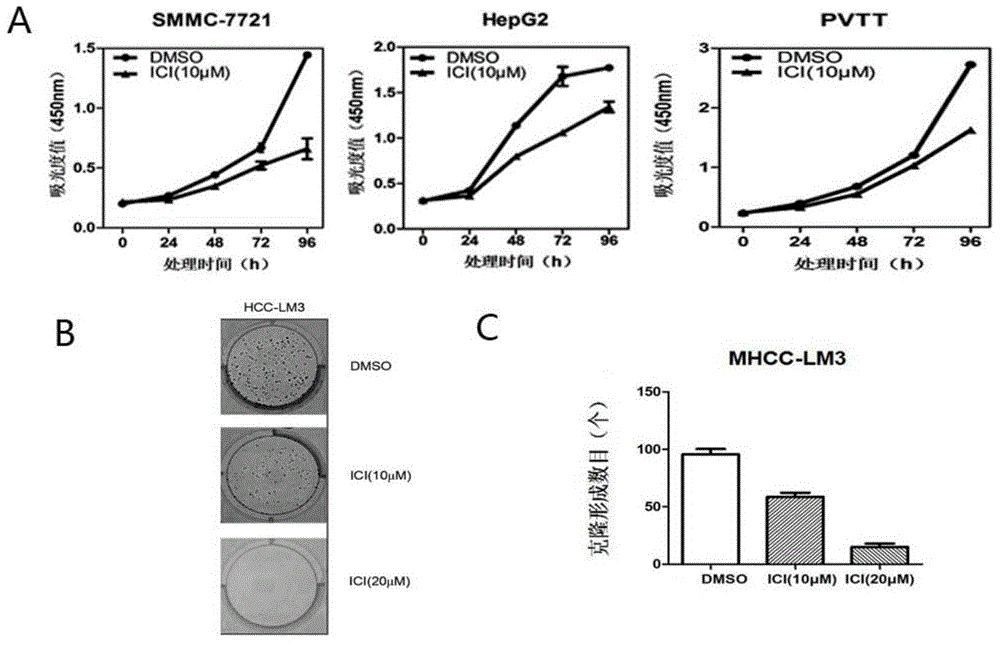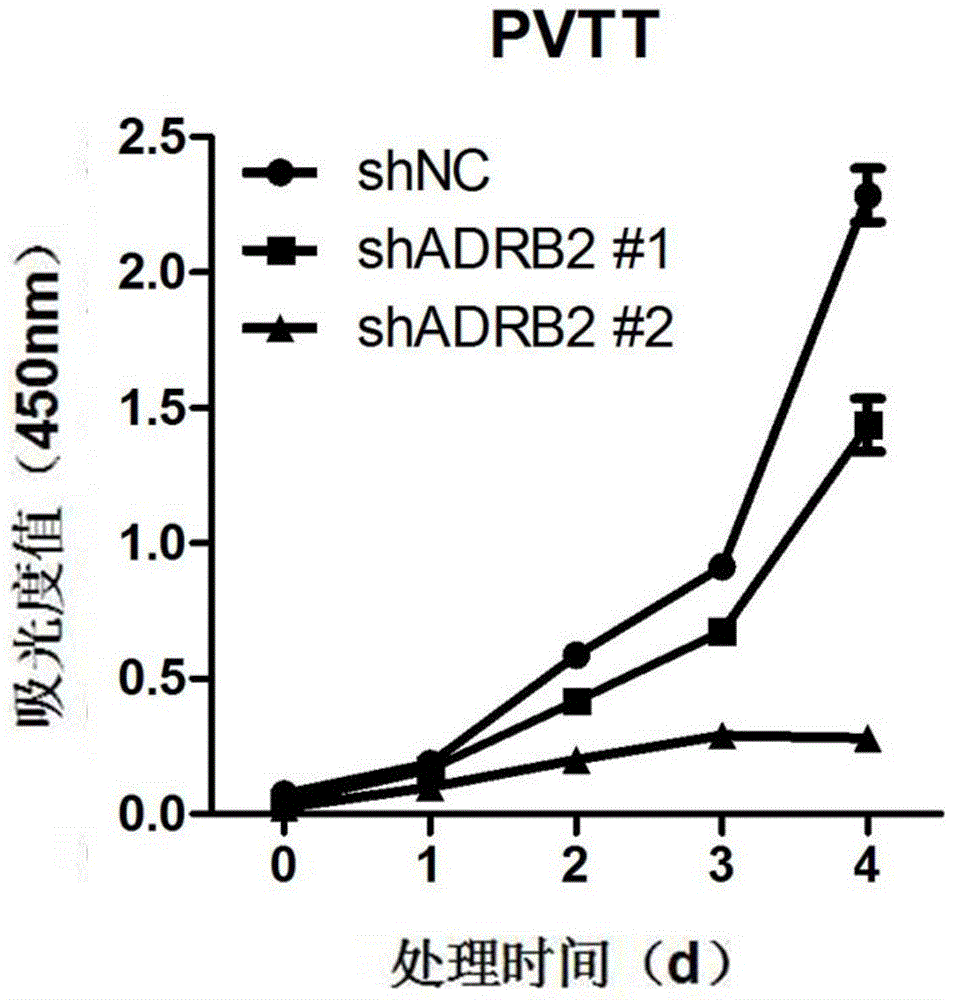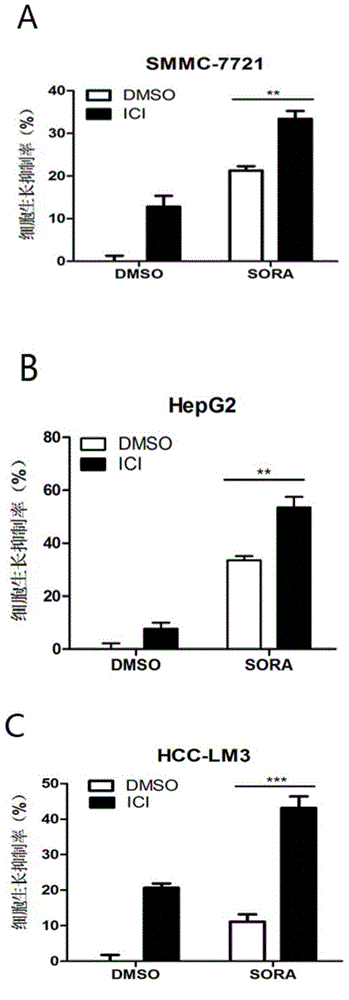Application of ADRB2 inhibitor and sorafenib combination in preparation of medicine for treating liver cancer
A technology for the treatment of liver cancer and chemotherapeutic drugs, applied in the field of medicine, can solve the problem of unclear role of β2 adrenergic receptors, achieve the effect of inhibiting proliferation and cloning formation, inhibiting the efficiency of transplantation tumor formation, and being easy to promote in clinical use
- Summary
- Abstract
- Description
- Claims
- Application Information
AI Technical Summary
Problems solved by technology
Method used
Image
Examples
Embodiment 1
[0037] Liver cancer cell lines SMMC-7721, HepG2, and PVTT were introduced into 96-well plates, with 3000 cells per well. Each type of cells was divided into two groups: DMSO and ICI, and each group had 5 auxiliary wells. After the cells adhered to the wall, it was counted as time 0, and each group was given 10 μM DMSO or ICI respectively. The medium was sucked off at 0, 24, 48, 72, and 96 hours respectively, and 10% CCK8 detection reagent diluted with DMEM was added, and the absorbance value at 450 nm was detected after incubating at 37° C. for 1 hour. Growth curves were drawn using the absorbance values measured at each time point.
[0038] Depend on figure 1 It can be seen from middle A that ICI can significantly slow down the proliferation rate of liver cancer cells within 24 hours, and this trend becomes more and more significant as time goes on.
[0039]In order to further prove that ICI can inhibit the proliferation of liver cancer cells, we conducted cell cloning ex...
Embodiment 2
[0042] The liver cancer cell line PVTT was introduced into a 12-well plate, and the cell density was about 50%. After the cells adhered to the wall, add 15 μL each of the control lentivirus or two shADRB2 viruses with different interference sites to the cell culture medium suspension, and shake well. After 8 hours, the medium was changed, and after 24 hours, puromycin with a concentration of 5 μM was added to continue the cultivation. When the cell density reached 100%, the cells were transferred to a 6-well plate and continued to cultivate. After identifying the interference effect by RT-PCR, the cells were introduced into a 96-well plate with 3000 cells per well. After the cells adhered to the wall, it was counted as 0 time, and the medium was sucked off at 0, 24, 48, 72, and 96 hours respectively, and 10% CCK8 detection reagent diluted with DMEM was added, and the absorbance at 450nm was measured after incubating at 37°C for 1 hour. value. Growth curves were drawn using t...
Embodiment 3
[0045] The liver cancer cell lines SMMC-7721, HepG2 and HMCC-LM3 were introduced into 96-well plates with 5000 cells per well. After the cells adhered to the wall, they were divided into four groups, with 5 auxiliary wells in each group, and each group was replaced with the medium containing the following drugs:
[0046] 1) DMSO;
[0047] 2) ICI 20μM;
[0048] 3) Sorafenib 20μM+DMSO;
[0049] 4) Sorafenib 20 μM + ICI 20 μM.
[0050] After incubation in a 37°C incubator for 24h, the culture medium was sucked off, and 10% CCK8 detection reagent diluted with DMEM was added, and the absorbance value at 450nm was detected after incubation in a 37°C incubator for 1h. Based on the absorbance value detected in the first group, calculate the inhibition rate of cells in groups 2-4, and draw a histogram of growth inhibition.
[0051] Depend on image 3 It can be seen that ICI combined with Sorafenib can significantly increase Sorafenib's growth inhibition on liver cancer cells, and ...
PUM
 Login to View More
Login to View More Abstract
Description
Claims
Application Information
 Login to View More
Login to View More - R&D
- Intellectual Property
- Life Sciences
- Materials
- Tech Scout
- Unparalleled Data Quality
- Higher Quality Content
- 60% Fewer Hallucinations
Browse by: Latest US Patents, China's latest patents, Technical Efficacy Thesaurus, Application Domain, Technology Topic, Popular Technical Reports.
© 2025 PatSnap. All rights reserved.Legal|Privacy policy|Modern Slavery Act Transparency Statement|Sitemap|About US| Contact US: help@patsnap.com



